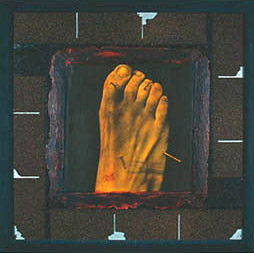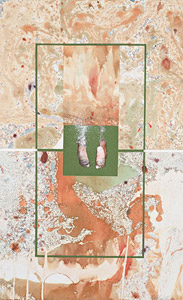“Emphasis” by Juan Antonio Molina |
chapter I | chapter II | chapter III | chapter IV | chapter V
III
The term “neo baroque” has a specific meaning and use, particularly when identifying the style of certain zones of Latin American art. It’s a terminology that is very well adapted to some manifestations of the figure within this type of art, and connects it to literary, historic and mythological precedents. I’d like to evoke that term to refer to that part of the photographic production in which emphasis is expressed through the rhetorical construction of the figure and the ideological construction of the body, resulting on the quasi-pictorial construction of the photo.
The coincidence of these three variables is preceded by a dynamics that acts upon (acts, updates, stages and simulates) the aesthetic function of the object through the aesthetic function of its making. The expressivity of the surfaces, their illusory textures, their condition of dramatized matter, would refer -almost with nostalgia- to the contact, to the making and presence that were in the origin of each work.
The final appearance would refer to a sort of abundance, not necessarily determined by the proliferation of visual elements, but by its intensity. And by the way, that intensity of the visual stimulus invites the most sensorial part of the reception of each work to have pleasure. This lust of sorts can be concentrated in the photographed body, but also in the body of the work. It seems to me that the emphasis in the surface of the photograph is the bearing of a particular eroticism that affects the photographic image.
There are works by Victor Vazquez where this effect is appreciated in an especially acute manner. This value that comes from craft, is also stressed in the work of Luis Gonzalez Palma. Some critics have interpreted it as “New Pictorialism”. In reality, it is about playing with tangential relationships between photography and iconographic paradigms, already coded by the history of painting, or rather by the history of representation in Western Culture. I believe certain reminiscences of Christian religious models can be seen in these iconographic paradigms. These models have been transformed, subverted or even parodied, but they still are active, almost clandestinely, giving more aesthetical effectiveness.
I find these references in the way Gonzalez Palma has represented “angelical” figures, or in the way Marta Maria has recuperated the theme of the stigmata in her most recent work. But above all I think about the work of victor Vazquez, who has worked with the duality of naked body/tormented body, as a metaphor of pain and pleasure, since they compose the plenitude of flesh. Bodegon de Yemaya (1994) is an exemplary work in this sense, since it duplicates the eroticism of the flesh in the eroticism of the artistic object, and this process is a manipulation, and an aesthetical re-making of the sacred1. I’d even say that the sacred is evoked from the representation of the body is somehow annulled by the representation itself. |
"Bodegon Yemayá" |
This effect has its own implications in photography, which seemed historically destined to sacralize what was represented and making it an object of cult. The different varieties of the representation of the body in photography, uses aesthetic procedures that sometimes reverse the fetishist logic of the represented, by amplifying the erotic/aesthetic quality of the very photographic object.2 The best work of Victor Vazquez, Juan Carlos Alom, Marta Maria Perez, Mario Cravo Neto or Gerardo Súter have implemented this transitional effect, which re-thinks and even questions the tradition of nude photography, by implying a self-referential dynamics, which is a premise for the critical relationship with the very act of representation and the resulting objects.
On the other hand, the absorption of the sacred by the aesthetic, bestows that very subtle vibration given by the rubbing between desire and prohibition. Even in a work such as Nestor Millan’s, which is totally aesthetic, the representation of the body has that ambiguity between cult and desire, repression and sublimation. Perhaps this is why in many of his pictures, the body seems to be submitted to a sort of violence that results in a gloomy and anxious tone.
"Change of skin III" |
1. I’d like to complete thios comment with a very lucid reading of this work by critic Ruben Rios Avila: “Bodegón de Yemayá” seems to be tha amplification, the blow up of a crucifiction, a nalied Christ foot. Teh scale the double framing, the red stains and the also red interior frame seem all to be directed to the ritual scene of sacrifice (…) The ritual scene makes way for the photographic composition, but the composition, the montage overtakes the sapce, almost completely neutralizing the emotional impact of the religious reference. In Bodegón de Yemayá the pictoric tradition of sacrifice is aestheticizedand becomes a pretext to explore the emotion provoked by the exaggeration of the blow up, and above all the beauty of the texture, the sensation of the magical contact between the nail and the skin, the astonishing silence of the light over the skin against the black backdrop. Photography hasd sensualized profoundly the scene of the sacrifice….” See Rubén Ríos Avila. El montaje del sacrificio. In “El cuerpo y el autorretrato extendido”. (Exhibition Catalog). San Juan, Puerto Rico. Galería Botello, 1994.
2. This reversal is also found in a kind of photography focused in objects more tha in the body human. It seems to me that the work of Chema Muñoz is a good example of that kind of netralization of the represented fetish by a fetish-ization of the representation itself. Even in that case, the photographed objects have a strong contamination by the human presence, contac and use (something similar happens with the photos of Vick Muñiz or Mauricio Alejo) In general, the photographed arrives to the image already ideologically contaminated, bearing meanings that have been assigned to it or that have been amplified by the very act of representation.

